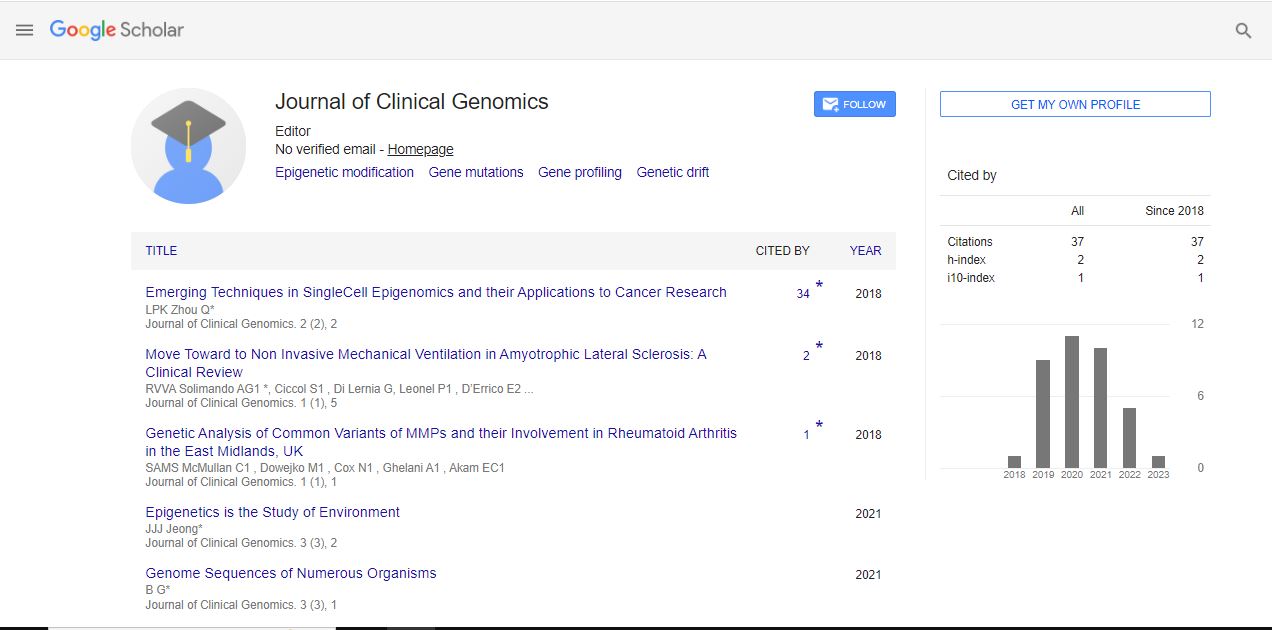Short Communication, J Chromatography Res Vol: 6 Issue: 4
A Comparative Analysis of Solid-Phase Extraction (SPE) and Liquid-Liquid Extraction (LLE) in Chromatographic Sample Preparation
Łukas Milagres*
1Department of Analytical Chemistry, Gdansk University of Technology, Gdansk , Poland
*Corresponding Author: Łukas Milagres,
Department of Analytical Chemistry,
Gdansk University of Technology, Gdansk, Poland
E-mail: milagresluca54@gutc.pl
Received date: 27 November, 2023, Manuscript No. JCGR-24-123794;
Editor assigned date: 29 November, 2023, PreQC No. JCGR -24-123794(PQ);
Reviewed date: 14 December, 2023, QC No. JCGR-24-123794;
Revised date: 21 December, 2023, Manuscript No. JCGR-24-123794(R);
Published date: 28 December, 2023, DOI: 10.36648/JCGR.1000082.
Citation: Milagres L (2023) A Comparative Analysis of Solid-Phase Extraction (SPE) and Liquid-Liquid Extraction (LLE) in Chromatographic Sample Preparation. J Chromatography Res 6:4.
Description
Chromatography, a cornerstone in analytical chemistry, relies on effective sample preparation techniques to ensure accurate and reliable results. Solid-Phase Extraction (SPE) and Liquid-Liquid Extraction (LLE) are two prominent methods employed for extracting and concentrating analytes from complex matrices [1,2].
Principle of solid-phase extraction
Solid-Phase Extraction is grounded in the selective adsorption and desorption of analytes onto and from a solid sorbent. The solid-phase, often packed into a cartridge or disk, possesses specific chemical and physical properties that enable the preferential retention of target analytes. The choice of sorbent material, including silica-based compounds, polymers, and bonded phases, dictates the selectivity of the extraction. The SPE process typically involves conditioning the solid-phase, loading the sample onto the sorbent, washing away unwanted matrix components, and eluting the analytes for subsequent analysis [3,4].
Conditioning enhances the sorbent's affinity for target analytes, while washing removes interfering substances. Elution, achieved by flushing the solid-phase with an appropriate solvent, yields a concentrated extract ready for chromatographic analysis. SPE finds extensive applications across diverse fields, including environmental analysis, pharmaceuticals, food and beverage testing, and clinical research. In environmental studies, SPE is instrumental in extracting pollutants from water, soil, and air samples. In pharmaceuticals, it aids in purifying and concentrating drug compounds from complex biological matrices. The technique's high selectivity makes it invaluable when dealing with intricate sample matrices [5].
Various SPE configurations exist to accommodate different sample types and analytes. Normal-phase SPE, reverse-phase SPE, ionexchange SPE, and mixed-mode SPE are among the common variants. Each type offers distinct selectivity based on the interactions between the solid sorbent and the analytes. The technique allows for the selective retention of analytes based on specific interactions with the solid sorbent. SPE can be adapted to a wide range of analytes and sample matrices. Concentration of analytes enhances the sensitivity of downstream chromatographic analysis. SPE is easily automated, making it suitable for high-throughput analysis [6,7].
Principle of liquid-liquid extraction
Liquid-Liquid Extraction, also known as solvent extraction, relies on the differential solubilities of target analytes in two immiscible liquid phases. Typically, an organic solvent and an aqueous phase are used, and during extraction, analytes partition between these phases, achieving separation from interfering matrix components [8].
Workflow of liquid-liquid extraction
The LLE process involves sample preparation, extraction, separation, and concentration. After preparing the sample, an organic solvent is added to form two distinct layers. Through mixing, analytes move from the aqueous phase into the organic phase or vice versa. After phase separation, the organic phase containing the target analytes is collected and concentrated for subsequent analysis [9].
Applications of liquid-liquid extraction
LLE is widely applied in environmental analysis, pharmaceuticals, and food and beverage testing. In environmental studies, LLE is used to extract pollutants from water and soil samples. In pharmaceuticals, it facilitates the purification of drug compounds from complex biological matrices. The simplicity and effectiveness of LLE make it valuable in laboratories dealing with diverse sample matrices [10].
Conclusion
In conclusion, both Solid-Phase Extraction (SPE) and Liquid- Liquid Extraction (LLE) play pivotal roles in chromatographic sample preparation, each with its unique strengths and applications. SPE excels in providing high selectivity and adaptability to various analytes and sample matrices, making it suitable for complex analyses. On the other hand, LLE, with its simplicity, versatility, and costeffectiveness, is well-suited for routine analyses and applications where selectivity requirements are not as stringent. The choice between SPE and LLE depends on the specific needs of the analysis, the characteristics of the sample, and the resources available in the laboratory. Researchers and analysts must carefully consider factors such as selectivity, versatility, ease of use, speed, sample size, and cost to determine the most suitable method for their particular application. Ultimately, the judicious application of these extraction.
References
- Bird IM (1989) High performance liquid chromatography: Principles and clinical applications. Brit Med J 299:783.
[Crossref] [Google Scholar] [Pubmed]
- Lough WJ, Wainer IW (1995) High performance liquid chromatography: Fundamental principles and practice. CRC press 30.
- Bressolle F, Bromet-Petit M (1996) Validation of liquid chromatographic and gas chromatographic methods Applications to pharmacokinetics. BioMed Sci Appl 686:3-10.
[Crossref] [Google Scholar] [Pubmed]
- Niessen WM (2006) Liquid chromatography-mass spectrometry. CRC press.
- Kostanyan AE, Voshkin AA (2009) Support-free pulsed liquidliquid chromatography. J Chromatogr. 1216.
[Crossref] [Google Scholar] [Pubmed]
- Pereira A (2010) Green chromatography introduction and liquid chromatography. LC GC Eur 23:242-259.
- Cielecka-Piontek J, Zalewski P, Jelińska (2013) The greening face of liquid chromatography. Chromatographia 76:1429-1437.
[Crossref] [Google Scholar] [Pubmed]
- Fanali S, Haddad PR, Poole C (2017) Liquid chromatography: Applications. Elsevier 25.
- Akash MS, Rehman K (2020) High performance liquid chromatography. Pharm Anal 175-84.
- Den Uijl MJ, Schoenmakers P (2021) Recent applications of retention modelling in liquid chromatography. J Sep Sci 44:88-114.
[Crossref] [Google Scholar] [Pubmed]
 Spanish
Spanish  Chinese
Chinese  Russian
Russian  German
German  French
French  Japanese
Japanese  Portuguese
Portuguese  Hindi
Hindi 